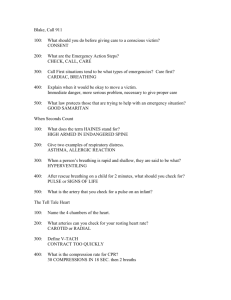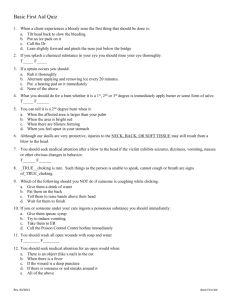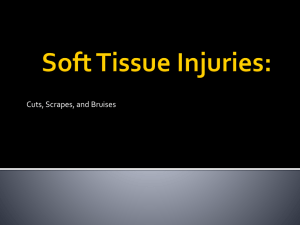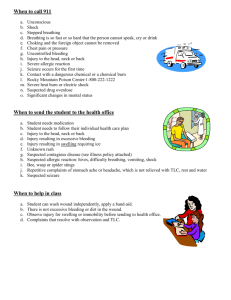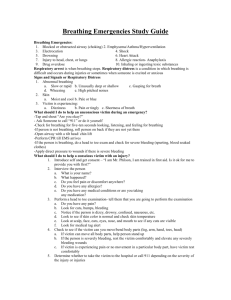DO NOT
advertisement
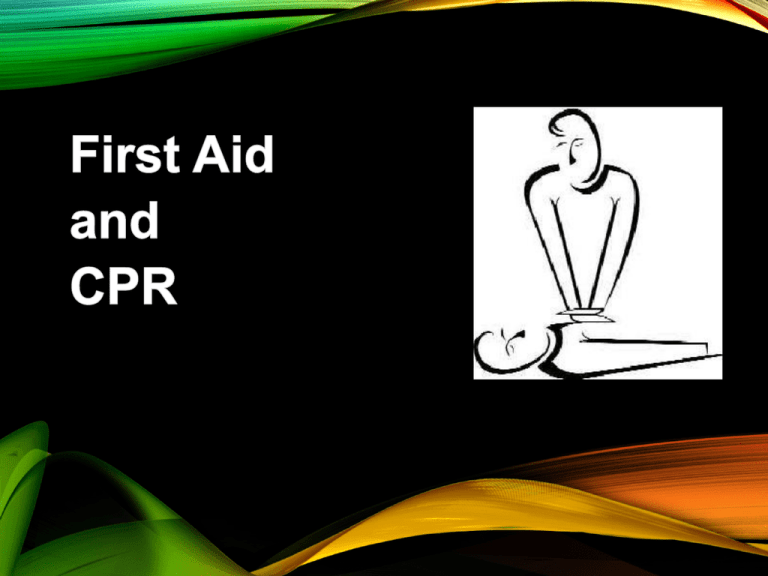
WHY DON’T PEOPLE WANT TO HELP IN AN EMERGENCY???? • Presence of others • Uncertainty about the person’s condition • Fear of catching a disease • Fear of doing something wrong • Fear of being sued • Being unsure of when to call 911 • Scared of blood #1 CAN I GET IN TROUBLE IF I HELP SOMEONE? • All 50 states have Good Samaritan Laws • Enacted to protect people who voluntarily give emergency care, without accepting anything in return. • Laws protect you as long as you – • Act in good faith • Are not negligent • Act within the scope of your training HOW DO I PREVENT DISEASE TRANSMISSION Use Universal Precautions - Avoid contact with: • Blood • Body fluids - Use PPE (personal protective equipment) such as: • Gloves • CPR barriers - Wash hands immediately after care #2 WHAT CAN I DO? • Provide Care - maintain normal body temperature - loosen tight clothing - reassure victim help is coming - learn basic first aid skills for common injuries • Be Prepared… - keep a list of emergency numbers near by - know where family health records are kept - keep first aid supplies both at home and in a vehicle FIRST AID KIT • Having several first aid kits around can be helpful. • Keep one in the house, in the car, and always take one when camping or hiking. • Do you know what should be in your kit? • Basic First Aid Kit items: - scissors - bandages - tape - alcohol wipes - ibuprofen - gauze pads - rubber gloves - band aids #3 YOUR RESPONSIBILITY 1. DECIDE to act 2. CHECK the area 3. CALL the local emergency services 4. Provide CARE until help arrives DECIDE TO ACT! For the victim in an emergency to receive treatment, someone must act. Someone needs to help, why not you?? YOUR RESPONSIBILITY 1. DECIDE to act 2. CHECK the area 3. CALL the local emergency services 4. Provide CARE until help arrives #4 You should determine: - CHECK THE AREA AROUND THE EMERGENCY What kind of an emergency Is it safe for you and victim The number of victims The cause of the injury Any unusual smells How are the victims behaving Any unusual noises YOUR RESPONSIBILITY 1. DECIDE to act 2. CHECK the area 3. CALL 911 for help 4. Provide CARE until help arrives CALL FOR HELP It is very important after you check a scene of an emergency to decide if emergency personnel is needed. - How do I know? Is emergency life threatening? Are you sure you know how to help? The most important action for you to take at an emergency is to - It will start emergency medical help on its way as fast as possible. LIFE THREATENING EMERGENCY? An emergency may be life threatening if the person: o Is unconscious, unresponsive, or not awake. o Is having trouble breathing or is not breathing. o Is not moving. o Is bleeding severely and the bleeding cannot be stopped. o Is having chest pain. If you are unsure if an emergency situation is life threatening or not, call 9-1-1. YOUR RESPONSIBILITY 1. DECIDE to act 2. CHECK the area 3. CALL the local emergency services 4. Provide CARE until help arrives PROVIDING CARE When providing care it is important to remember: Remain calm!!! Remember to ask for consent to treat. What is your level of training? ALWAYS treat life threatening victims first! Watch for changes in breathing or consciousness #5 OBTAINING CONSENT • Before helping someone, you MUST obtain permission to help someone • If someone refuses care, call 911 for them • If unconscious, confused or seriously ill & not able to grant consent, the consent is implied. • If a minor, get consent from parent or guardian HOW DO I ASK TO HELP? To Obtain Consent: • • • • • State your name Tell the person you are trained in first aid Ask the person if you can help Explain what you think might be wrong Explain what you plan to do CONSCIOUS VICTIM 1. Check breathing- is it labored? 2. Introduce yourself and ask permission to help 3. Explain your training 4. Ask what happened and ask about the injury 5. Decide if you can help them or do you need paramedics UNCONSCIOUS VICTIM 1. Check for breathing - if yes, roll onto side - if no, then you must start CPR 2. Check for bleeding WHAT IS FIRST AID? It is the temporary care given to a person who becomes injured or ill. Knowing what kind of first aid to provide can prevent serious and sometimes permanent damage to the victim. In some cases, first aid can even prevent death. You need to handle each emergency differently, depending on the severity of the illness or injury. SOFT TISSUE INJURIES TYPES OF WOUNDS 1. Soft tissues include layers of skin, fat, & muscle 2. Damage may be at the skin level or deeper in the body 3. A physical injury that damages the layers of skin is called a wound. 4. Wounds are typically classified as either opened or closed. CLOSED WOUNDS #6 Closed: wounds where the skin’s surface is not broken. The simples closed wound is a bruise. It is caused by a blow to the body that damages the soft tissue layer and causes internal bleeding. When to call 911- OPEN WOUNDS OPEN WOUNDS – the skin’s surface is broken, and blood may come through the tear in the skin. Types of open wounds: • Abrasions – caused by something rubbing against skin • Lacerations- a cut in the skin #6 #7 • Types of open wounds cont.: • Avulsions – when a portion of the skin is partially or completely torn away - Ice the area immediately • Punctures- occur when a pointed object such as a nail, pierces the skin - bacteria can get in the wound, so you most likely will need a tetanus shot NEED STITCHES? Rule of thumb: if you are wondering if it needs stitches, it probably does Used when edges of skin don’t fall together When cut is on the face Any wounds over ½ inch long Wounds that are deep #8 CONTROLLING OPEN WOUND BLEEDING • Cover the wound with a sterile dressing -If it bleeds through dressing, apply another dressing over previous… NEVER remove a dressing. • Apply direct pressure until bleeding stops • Cover the sterile dressing with a bandage. Make sure it is not too tight that it cuts off circulation. TYPES OF BURNS Cause: • • • • Thermal (heat) Chemicals Electricity Radiation #9 Classifications: by depth • 1st degree • • • • sunburn epidermis only never blisters not calculated in burn extent • 2nd degree • • • • through the epidermis into the dermis blister develop pink, moist, painful can hurt the worst • 3rd degree • All three layers burned • May be tissue damage to the bone • May or may not be painful # 10 CARING FOR A MINOR BURN • Do: • Check scene for safety • Remove source of burn • Cool 1st and 2nd degree burns with cool running water • Cover wound loosely with a sterile dressing • DO NOT!!!! • • • • • • Use ice Break blisters Remove pieces of clothing stuck to burn Use any type of ointment on a severe burns Do not immerse 3rd degree burns in water Do not touch the area of a burn with anything but a clean covering Would you put it on a burn? Click yes or no! Yes No No! A doctor would have to scrape butter off the burn before treating it. Ouch! No! Cotton wool will stick to the burn. Never cover a burn with anything fluffy. 1. Butter 2. Cotton wool Yes! Use water to cool a burn for at least 10 minutes. Yes! If you haven’t got water to cool a burn, a cold liquid, like milk will do Yes! The gauze will keep it clean. 3. Cold water 4. Cold milk 5. Sterile gauze CHEMICAL BURNS • Remove contaminated clothing if possible • Brush off dry chemicals • Flush burn with water for 15 to 20 minutes • Flush eye, if chemical in eye, for 15 – 20 min. ELECTRICAL BURNS • Look First, Do Not Touch • DO NOT go near person until he/she is not in contact with power source • High-voltage: call 911 • Turn off power source • Observe for cardiac arrest • Care for shock, thermal burns • All need advanced medical care • These burn from the inside – out • They are extremely dangerous SUDDEN ILLNESSES SUDDEN ILLNESS General Guidelines • Do no further harm • Monitor breathing and consciousness • Help the person rest in the most comfortable position • Keep the person from getting chilled or overheated • Reassure the person • Give any specific care needed FAINTING • Temporary loss of consciousness • Caused by a temporary reduction of blood flow to the brain • Usually self-correcting • Victim recovers quickly with no lasting effects • Place victim on their side in a resting position DIABETIC EMERGENCY • Body does not produce enough insulin or does not use insulin effectively • If victim conscious and able to swallow: • They might need help injecting • Give sugar • If victim unable to swallow or sugar not available call 911 # 11 What are they? SEIZURE Disruption of normal electrical activity of the brain causing a loss of body control • What can you do? o Do NOT put anything in their mouths o Do NOT restrain the person o Prevent injury o Make sure person is breathing Video – 5:30 min Seizures—call 9-1-1 if: o They are injured or remains unconscious when the seizure is over. o The person is pregnant or has diabetes. o The person is very young or very old. o It is the person’s first seizure. POISONIN G Definition: • Any substance that can cause injury, illness or death when introduced into the body How introduced into the body: • Inhalation • Swallowed • Absorption • Injection Treatment • If life threatening call 911 • Call Poison Control Center and follow their directions 1-800-222-1222 • DO NOT give anything by mouth CHOKIN G Suddenly your friend starts choking on a piece of food… … struggling for breath… holding his throat… turning red in the face… What do you do????? First ask: “Are you choking?” mild choking severe choking both unable to speak answers when questioned difficulty breathing unable to breathe coughs holding throat red face unable to cough Sort the boxes into the Venn diagram. See the next slide for answers… # 12 mild choking both coughs severe choking unable to breathe red face answers when questioned holding throat difficulty breathing unable to cough unable to speak If choking is mild, encourage the choking person to cough. This should clear the problem. If your friend can’t speak or cough, the choking is severe. Airway Your friend’s airway has been blocked by food. Unable to breathe, your friend may quickly pass out. Food You must act right away. # 13 When someone’s choking badly, you must do something. The video clip shows you what to do… # 14 STROK E What is it? It is when the blood flow to an area of brain is cut off. This deprives th brain cells of oxygen and begin to die. • Think F.A.S.T. o F = Face – weakness on one side o A = Arms – weak or numb o S = Speech – slurred or trouble talking o T = Time – call 911 now!! # 15 What is it? SHOC K Life-threatening condition in which there is not enough blood being delivered to all parts of the body When can you get it? Can happen after a serious injury or illness including: • severe bleeding • Serious internal injury • Blood or body fluid loss What are the signs? • • • • • • Restlessness or irritability Altered level of consciousness Nausea or Vomiting Pale, ashen, cool, moist skin Rapid breathing and pulse Excessive thirst How do you take care of someone in shock? • Call 911 • Remain calm • Have the person lie down • Control any external bleeding • Cover with a blanket • DO NOT give anything to eat or drink • Reassure the person • Monitor airway, breathing, and circulation ALLERGIC REACTION Cause: • • • • Drugs Medications Foods Chemicals Treatment: • Check • Call • Care • Give care for any life-threatening condition • Epinephrine auto-injector # 16 BITES & STINGS • Insect Stings • • • • Scrape away the stinger Wash site with soap and water Cold pack to reduce pain Watch for signs of an allergic reaction • Tick Bites • Remove tick with tweezers as close to skin as possible and pull slowly • DO NOT • Burn tick off • Apply petroleum jelly • If rash, flu-like sx, or joint pain seek medical care Severe reactions include: weakness, swelling of the face and neck, and difficulty breathing. If these signs are present… call 911 INJURIES TO MUSCLES, BONES, AND JOINTS # 17 TYPES OF MUSCLE, BONE AND JOINT INJURIES • Fractures: break in bone • Open Fracture: skin over fracture broken • Closed Fracture: skin over fracture intact • Dislocation: displacement of a bone at the joint • Sprain: partial or complete tearing or stretching of a ligament • Strain: stretching or tearing of muscles or tendon fibers # 18 CARE FOR MUSCULOSKELETAL SYSTEM Think RICE! • Rest • Ice • Compress • Elevate • Rest • Immobilize • Cold • Elevate WHEN DO YOU CALL 911? • Open fracture—you can see bone • Cannot move or use the hurt part normally (for example, if the person cannot stand on his/her leg) • Area is cold and numb • Involves the head, neck or spine • Trouble breathing SPLINTIN G • Definition: method of immobilizing • Splint injury in position in which you find it • Splint the injured area and the joints or bones above and below the injury site • Check for circulation • Feeling, warmth, and color TYPES OF SPLINTS • Soft Splint • Use of pillows, folded blankets, towels, & a sling • Rigid Splint • Includes boards, metal strips & folded magazines or newspapers • Use a triangular bandage • Anatomical Splints • Use uninjured body part as a splint to immobilize an injured area ANATOMIC SPLINT 1. Get consent to treat 3. Align body parts 2. Check circulation 4. Tie bandages securely 3. Position bandages 5. Recheck circulation SOFT SPLINT 1. Support injured part 3. Wrap with soft object 2. Check circulation 4. Tie bandages securely 3. Position bandages 5. Recheck circulation # 19 HOT OR COLD After an injury ice can be very beneficial. It can: THERAPY? •Reduce bleeding within tissues •Prevent or reduce swelling •Reduce muscle spasm •Reduce pain by numbing the area and reducing swelling (which causes pain through pressure) Ice or cold packs should be applied for 15-20 minutes every 2-3 hours. Be sure to protect the skin if you apply ice/cold packs to prevent an ice burn. Heat is beneficial when the injury is 48-72 hours old, otherwise it can worsen the bleeding and inflammation. Heat can be applied in the form of: •Deep heat creams •Heat pads •Hot water bottles Heat works by dilating the blood vessels allowing more blood to the area which has a soothing effect. It eases pain and muscle spasms. NECK, HEAD, AND BACK INJURIES # 20 CARE FOR INJURIES TO THE HEAD, NECK, OR BACK • Call 911! • These injuries may cause unintentional death or life-long neurological damage • Minimize movement of the head, neck or back • Leave victim in the position found in If the head is turned sharply to one side, DO NOT try to align it. Support the head in the position you found it in. # 21 CONCUSSION S What are they? It is a type of traumatic brain injury that is caused by a blow to the head or body, a fall, or another injury that jars or shakes the brain inside the skull. • Signals o Loss of balance o Vision disturbances o Nausea and vomiting o Dizziness o Headache BRAIN INJURIES SIGNALS FOR BRAIN INJURIES: • Changes in consciousness, such as confusion and excessive sleepiness • Severe pain or pressure in the head, neck or back • Tingling or loss of feeling in the hands, fingers, feet or toes • Partial or complete loss of movement of any body part • Blood or other fluids draining from the ears or nose • Heavy external bleeding of the head, neck or back • Seizures • Trouble breathing or seeing as a result of the injury • Nausea or vomiting • Loss of balance (after the initial injury) • Bruising of the head, especially around the eyes and behind the ears WHEN DO I CALL 911? • Suspect a serious head or spinal injury when the person: o Says there is neck or back pain. o Has tingling or weakness in the arms or legs. o Is not fully alert. o Staggers when trying to walk. o Appears to be unexpectedly weak. Call 9-1-1. HEAT & COLD RELATED EMERGENCIES # 22 What is it? HYPOTHER MIA When your body loses heat faster than it can produce it. Normal body temperature is around 98.6° F Hypothermia is when the body temperature passes below 95° F. When does it happen? When there is overexposure to cool temperatures, cold water, moisture, and/or wind. What happens to the victim? -shivers and feels cold -trouble speaking -tired -confused -pulse rate slows down and becomes irregular -can become unconscious and die if not treated HYPOTHER MIA CONT. What do you do? - call 911 ASAP - handle them carefully - try to get them to a warmer environment - remove wet clothing and put on dry clothing # 23 FROSTBIT E What is it? The freezing of body parts exposed to the cold. What to look for: -lack of feeling -skin swollen and waxy looking -skin cold to the touch -skin may be discolored -blisters may form -may turn black if severe FROSTBIT E CONT. Call 911 if severe! Until help arrives: • handle the area gently • remove wet clothing and jewelry • if minor, you can rewarm the area using skin-to-skin contact • Warm them up slowly! NEVER: • rub the area • rewarm the area if there is a chance it might refreeze or you are going to the hospital • give ibuprofen • break the blisters HEAT-RELATED ILLNESSES Heat cramps, heat exhaustion and heat stroke and all caused by overexposure to heat, loss of fluids and electrolytes. HEAT EXHAUSTION is more severe than heat cramps. It affects, athletes, firefighters, construction works or factory workers most often. Signs: cool, moist, pale, ashen or flushed skin; headache;nausea;dizzine4ss; weakness; and exhaustion What do you do? - get them out of the heat - give cool liquids - loosen or remove clothes - let the person rest # 24 HEAT STROKE: CALL 911!!!!! Least common, but most severe of heat related illnesses. Occurs when people ignore the warning signals of heat exhaustion. Watch for: - extremely high body temp - red skin that can be dry or moist - changes in consciousness - confusion - rapid or weak pulse - shallow breathing Cool them off - vomiting ASAP! - seizures

